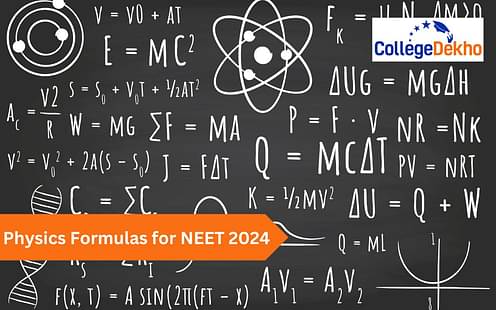
How many times has it happened that you wanted to learn or revise aPhysics formula for NEET 2024 and you had to sift through the entire textbook to find one? How many times did you wish that you could refer to any formula instantly without going through so much hassle? These challenges are some of the most common issues students face during the NEET 2024 Exam Preparation. With the NEET Exam 2024 scheduled to be held on May 5, 2024, limited time is left for preparation. Applicants must start to brush up on the important formulas for NEET Physics to score good marks in the Physics portion.
NEET Exam 2024 is the biggest medical entrance exam in India with almost 21 lakh test takers every year. The NEET Syllabus 2024 includes the entire syllabus of Physics, Chemistry, and Biology. The Physics section of the NEET syllabus 2024 is divided into 2 sections - Section A containing 140 marks and Section B containing 40 marks. All the questions will be multiple-choice based. A major part of preparing the physics paper is to memorize the NEET Physics important formulas by heart. Learning the Physics formula for NEET 2024 will help the aspirant to ace the exam. Students can scan through this article to find out the Physics formulas for NEET 2024.
Also Read:
NEET Physics Important Formulas
Candidates need to prepare all the physics formulas for NEET for the accurate application of principles and physics concepts. So, to gauge a topic better, one has to be aware of all the Physics formulas for NEET. Here are some crucial Physics formulas for NEET 2024 that one must refer to:
Boltzmann constant, k = 1.38 × 10−23 J/K
Gravitation constant, G = 6.67×10−11 m3 kg−1 s−2
Planck constant, h = 6.63 × 10−34 J.s = 4.136 × 10-15 eV.s
a = ∆v ∆t, where A = acceleration, ∆v = change in velocity and ∆t = elapsed time.
Charge of electron, e = 1.602 × 10−19 C
Avogadro’s number, NA = 6.023 × 1023 mol−1
Molar gas constant, R = 8.314 J/(mol K)
∆x = vf∆t − 1/2 a(∆t)2 where ∆x = displacement, vf = is the final velocity, ∆t = elapsed time and a = acceleration.
Wave = ∆x ∆t wave = displacement ∆t = average velocity ∆x = elapsed time.
Coulomb constant, 1/4πε0 = 8.9875517923(14) × 109 N m2/C2
Permittivity of vacuum 0 = 8.85 × 10−12 F/m
Stefan-Boltzmann constant, σ = 5.67 × 10−8 W/(m2 K4)
Mass of electron, me = 9.1 × 10−31 kg
Faraday constant, F = 96485 C/mol
p = mv
Mass of neutron, mn = 1.6749 × 10−27 kg
Mass of proton, mp = 1.6726 × 10−27 kg
Standard atmosphere, atm = 1.01325 × 105 Pa
Rydberg constant, R∞ = 1.097 × 107 m−1
Wien displacement constant, b = 2.9 × 10−3 m K
Bohr radius, a0 = 0.529 × 10−10 m
Bohr magneton, µB = 9.27 × 10−24 J/T
F = ma where m = mass, F = force, and a = acceleration Newton’s Second Law.
F is termed as the net force on the mass m.
f = µN f = friction force, where N = normal force and µ = coefficient of friction.
Here, µ can be considered either the kinetic coefficient of friction, µk, or the static coefficient of friction.
P = W ∆t P = power, where ∆t = elapsed time and W = work.
Power is the amount of work that is done per unit of time; that is, power is the rate at which work is done.
Vavg = (vi + vf*)2 where vi = initial velocity and vf = final velocity.
KE = 1/2 mv2 K, where KE = kinetic energy, m = mass, v = velocity.
∆x = vi∆t + 1/2 a(∆t) where ∆x = the displacement, ∆t = the elapsed time, vi = the initial velocity, and a = the acceleration.
W = mg, where m = mass, W = weight, and g = acceleration which is due to gravity.
Then, we weigh an object called mass, m. This is said to be Newton’s Second Law.
W = F.d or W = F d cos θ, where W = work, d = distance, F = force, and θ = angle between F and the direction of motion.
W = ∆(KE), where KE = kinetic energy and W = work done.
The ‘work-energy’ that we have learned is the theorem that the work done by the net force on an object equals the change in kinetic energy of the object.
We can write it as E = KE + PE, where E = total energy, KE = kinetic energy, and PE = potential energy.
Physics Chapter-wise Formulas for NEET PDF - Download Link |
|---|
How to Solve Numericals like a Pro using Physics Formulas for NEET 2024?
Important formulas for NEET physics are helpful for students while solving numerical problems. One must note that the weightage of numerical formulas is high in exams. Hence, one can follow these steps to solve the Physics Formulas for NEET 2024 like a pro.
Examine questions thoroughly and stay on the lookout for important keywords. Half of the job is done if you’re able to understand the questions correctly.
Jot down all the given data and recognize the problem type. This will help you eliminate a few options and also clear you from the clutter of twisted question framings.
Zero down on the ideal yet effective approach to solving the numerical. Know what type of question has been asked and solve the question with accuracy.
Once you’ve solved the question, look for the answers in the option. If you cannot find the answer in the options, they choose the solution closest to your answer. Sometimes, accuracy issues occur and hence the answer closest to your solution can be chosen.
Be confident with your approach and don’t second guess your solution after attempting the question. Move on to the next numerals and keep attempting them one by one.
Best Books to Learn Physics Formulas for NEET 2024
There are several NEET Physics 2024 reference books that candidates can refer to. However, the reference material in the books mentioned below is considered to be the best for studying NEET physics important formulas.
Concepts of Physics by H. C. Verma
NCERT (Textbook) Physics – Class 11 and 12
Objective Physics by D. C. Pandey
Fundamentals of Physics by Halliday, Resnick, and Walker
- Problems in General Physics by I. E. Irodov
How to Study Physics Formulas for NEET 2024 Correctly
Candidates can study all physics formulas for NEET the right way by following these techniques.
Practice all numerical instead of mugging up or trying to memorize the equations.
Solve different types of numerical to understand the applications of NEET Physics formulas.
Jot down all challenging formulas on a flashcard and create bite-sized content for quick reference as and when needed.
- Try to understand the logic behind how a formula is created. This will boost your formula recall significantly.
Also Read: NEET 2024 Most Important Topics to Remember
Importance of Physics Formulas for NEET 2024
The Physics section of the NEET 2024 exam comprises 45 questions. Overall, it accounts for 180 marks out of 720. Out of the 45 questions, most of them are numerical, i.e., formula based. Hence, aspirants must study all physics formulas for NEET thoroughly.
As per recent trends and previous years’ results, experts have estimated that the Physics section is where candidates make the most mistakes and lose a good chunk of marks. So, if one wishes to secure the most marks in the NEET 2024 exam, one needs to focus on truly understanding the Physics formulas for NEET 2024.
Also Read: NEET 2024 Chapter Wise and Subject Weightage, Important Topics
Related Articles
Revise these Chapters and Topics to Score Well in NEET 2024 Physics | |

















Similar Articles
NEET 2024 MBBS Seats in Government Medical Colleges
NEET 2024 Cutoff for Ayurveda (Expected) - General, OBC, SC, ST Category
Mizoram NEET 2024 Counselling: Dates, Registration, Choice Filling, Fees, Seat Matrix
Assam NEET Counselling 2024: Dates, Registration, Choice Filling, Documents Required, Seat Allotment
NEET Cutoff 2024 for Govt Colleges (15% AIQ) - General, SC, ST, OBC, EWS
Haryana NEET Counselling 2024: Dates, Registration, Choice-Filling, Seat Allotment, Document Verification, Seat Matrix